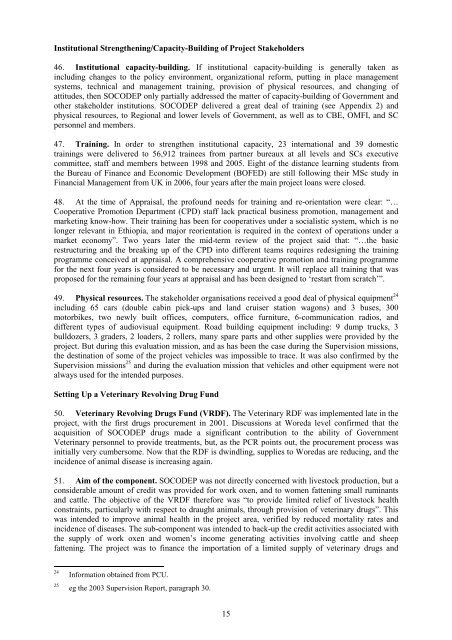Ethiopia SOCODEP CE - main report - IFAD
Ethiopia SOCODEP CE - main report - IFAD
Ethiopia SOCODEP CE - main report - IFAD
You also want an ePaper? Increase the reach of your titles
YUMPU automatically turns print PDFs into web optimized ePapers that Google loves.
Institutional Strengthening/Capacity-Building of Project Stakeholders<br />
46. Institutional capacity-building. If institutional capacity-building is generally taken as<br />
including changes to the policy environment, organizational reform, putting in place management<br />
systems, technical and management training, provision of physical resources, and changing of<br />
attitudes, then <strong>SOCODEP</strong> only partially addressed the matter of capacity-building of Government and<br />
other stakeholder institutions. <strong>SOCODEP</strong> delivered a great deal of training (see Appendix 2) and<br />
physical resources, to Regional and lower levels of Government, as well as to CBE, OMFI, and SC<br />
personnel and members.<br />
47. Training. In order to strengthen institutional capacity, 23 international and 39 domestic<br />
trainings were delivered to 56,912 trainees from partner bureaux at all levels and SCs executive<br />
committee, staff and members between 1998 and 2005. Eight of the distance learning students from<br />
the Bureau of Finance and Economic Development (BOFED) are still following their MSc study in<br />
Financial Management from UK in 2006, four years after the <strong>main</strong> project loans were closed.<br />
48. At the time of Appraisal, the profound needs for training and re-orientation were clear: “…<br />
Cooperative Promotion Department (CPD) staff lack practical business promotion, management and<br />
marketing know-how. Their training has been for cooperatives under a socialistic system, which is no<br />
longer relevant in <strong>Ethiopia</strong>, and major reorientation is required in the context of operations under a<br />
market economy”. Two years later the mid-term review of the project said that: “…the basic<br />
restructuring and the breaking up of the CPD into different teams requires redesigning the training<br />
programme conceived at appraisal. A comprehensive cooperative promotion and training programme<br />
for the next four years is considered to be necessary and urgent. It will replace all training that was<br />
proposed for the re<strong>main</strong>ing four years at appraisal and has been designed to ‘restart from scratch’”.<br />
49. Physical resources. The stakeholder organisations received a good deal of physical equipment 24<br />
including 65 cars (double cabin pick-ups and land cruiser station wagons) and 3 buses, 300<br />
motorbikes, two newly built offices, computers, office furniture, 6-communication radios, and<br />
different types of audiovisual equipment. Road building equipment including: 9 dump trucks, 3<br />
bulldozers, 3 graders, 2 loaders, 2 rollers, many spare parts and other supplies were provided by the<br />
project. But during this evaluation mission, and as has been the case during the Supervision missions,<br />
the destination of some of the project vehicles was impossible to trace. It was also confirmed by the<br />
Supervision missions 25 and during the evaluation mission that vehicles and other equipment were not<br />
always used for the intended purposes.<br />
Setting Up a Veterinary Revolving Drug Fund<br />
50. Veterinary Revolving Drugs Fund (VRDF). The Veterinary RDF was implemented late in the<br />
project, with the first drugs procurement in 2001. Discussions at Woreda level confirmed that the<br />
acquisition of <strong>SOCODEP</strong> drugs made a significant contribution to the ability of Government<br />
Veterinary personnel to provide treatments, but, as the PCR points out, the procurement process was<br />
initially very cumbersome. Now that the RDF is dwindling, supplies to Woredas are reducing, and the<br />
incidence of animal disease is increasing again.<br />
51. Aim of the component. <strong>SOCODEP</strong> was not directly concerned with livestock production, but a<br />
considerable amount of credit was provided for work oxen, and to women fattening small ruminants<br />
and cattle. The objective of the VRDF therefore was “to provide limited relief of livestock health<br />
constraints, particularly with respect to draught animals, through provision of veterinary drugs”. This<br />
was intended to improve animal health in the project area, verified by reduced mortality rates and<br />
incidence of diseases. The sub-component was intended to back-up the credit activities associated with<br />
the supply of work oxen and women’s income generating activities involving cattle and sheep<br />
fattening. The project was to finance the importation of a limited supply of veterinary drugs and<br />
24 Information obtained from PCU.<br />
25 eg the 2003 Supervision Report, paragraph 30.<br />
15

















